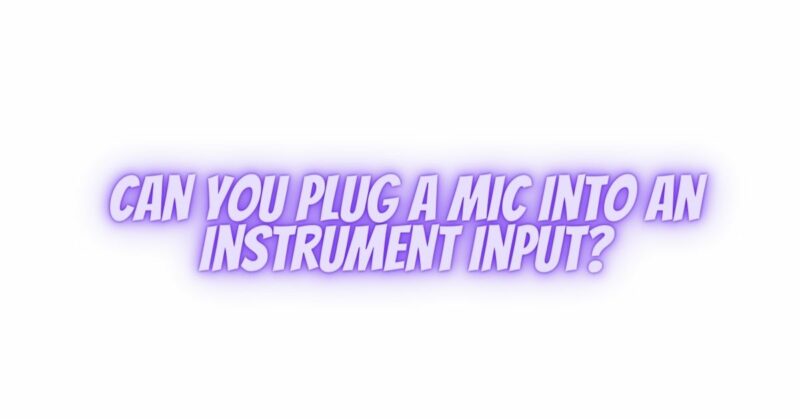Musicians and sound enthusiasts often encounter situations where they need to connect a microphone to an instrument input, such as those found on audio interfaces, mixers, or amplifiers. While it is possible to physically connect a microphone to an instrument input, it’s important to understand the implications, limitations, and potential consequences of doing so. In this comprehensive guide, we’ll explore the reasons behind this practice, the technical aspects involved, and the best practices for connecting a microphone to an instrument input.
Understanding Microphones and Instrument Inputs
Before diving into whether you can plug a microphone into an instrument input, let’s clarify the fundamental differences between microphones and instrument inputs:
Microphones: Microphones are transducers that convert acoustic sound waves into electrical audio signals. They typically have low-impedance (low-Z) outputs and require preamplification to bring their signal levels up to line level for proper recording or amplification.
Instrument Inputs: Instrument inputs, also known as Hi-Z (high-impedance) or line-level inputs, are designed to accept the output of instruments like electric guitars and basses. These inputs are optimized for high-impedance signals and are not typically equipped with the necessary preamplification for microphones.
Can You Plug a Microphone into an Instrument Input?
Physically, it is possible to connect a microphone to an instrument input using the correct cable and adapters. However, this practice raises several important considerations:
1. Impedance Mismatch:
Microphones typically have low-impedance outputs (around 150-600 ohms), while instrument inputs are designed for high-impedance signals (usually around 1 megaohm for electric guitars). Plugging a low-Z microphone into a high-Z instrument input can result in poor impedance matching, leading to a significant loss of signal quality and a less-than-optimal sound.
2. Signal Level:
Microphones produce very low-level signals, often in the millivolt range, while instrument inputs expect line-level signals, which are considerably higher in voltage. Without adequate preamplification, the microphone’s signal may be too weak to produce a usable sound when connected to an instrument input.
3. Lack of Preamplification:
Instrument inputs are not equipped with the necessary preamplification (also known as gain) to boost the low-level signal from a microphone to a usable level. As a result, the microphone’s sound may be barely audible or unusable.
4. Risk of Damage:
Plugging a microphone into an instrument input can potentially damage the input stage of the equipment due to the impedance mismatch and the higher voltage levels expected from an instrument input.
Best Practices and Solutions
To properly connect a microphone to an audio system, you should follow these best practices and consider appropriate solutions:
1. Use a Microphone Input:
Whenever possible, use a dedicated microphone input. These inputs are designed with the proper impedance, preamplification, and sensitivity to handle microphone signals optimally.
2. Use a Direct Box (DI Box):
If you need to connect a microphone to an instrument input, consider using a direct box (DI box) as an intermediary. A DI box can match the impedance and provide the necessary preamplification to convert the microphone’s low-level signal into a usable format for an instrument input. This solution is commonly employed for miking acoustic instruments, such as acoustic guitars and violins, in live sound and recording settings.
3. External Microphone Preamplifier:
Another option is to use an external microphone preamplifier before connecting the microphone to an instrument input. External preamps provide the gain and impedance matching needed to prepare the microphone’s signal for an instrument-level input.
4. Avoid Extreme Volume Levels:
If you must connect a microphone directly to an instrument input in an emergency situation, be cautious with volume levels. Keep the microphone close to the sound source and use as little gain as possible to minimize potential issues.
Conclusion
While it is physically possible to plug a microphone into an instrument input, it is not advisable due to the impedance mismatch, inadequate preamplification, and potential risk of equipment damage. To achieve the best results when using microphones, always use dedicated microphone inputs, direct boxes (DI boxes), external microphone preamplifiers, or other appropriate solutions that ensure proper impedance matching and signal conditioning. Properly handling microphone connections is essential for achieving clear and professional audio quality in both live sound and recording applications.

